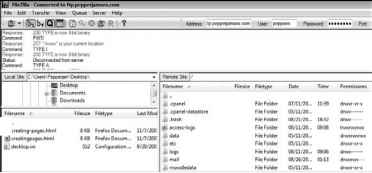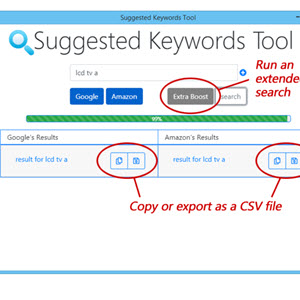Using Text Modifiers
As discussed in the previous task, you can modify text on a Web page to emphasize important keywords and phrases to help search engines and human visitors identify the main topic of that page. This can lead to higher rankings for those terms. Besides header tags, you can use other text-modifying tags to place emphasis on certain keywords, phrases, or blocks of text.
These tags include <strong>, <em>, <b>, <i>, and <u>. Usage of these tags works as follows:
<STRONG>Strongly emphasized text.</STRONG>
<EM>Emphasized text.</EM> <B>Bolded text.</B> <I>Italic text.</I> <U>Underlined text.</U>
Whereas header tags should be used to emphasize the main topics that logically break content into different sections, use these other text-modifying tags within those bodies of content.
Using Text Modifiers
Use the <STRONG> tag to strongly emphasize an important selection of text. If you want to stress a point that you are trying to get across, place it within a <strong> tag. Web browsers normally bold the text within a <STRONG> tag.
Use the <em> tag to emphasize an important selection of text. This tag is similar to the <strong> tag, but Web browsers tend to display it in the form of italicized text. Use the <b> and <i> tags if your intent is purely to bold or italicize text. These tags differ from the <STRONG> and <em> tags in that they are not intended to portray any semantic meaning. They are strictly presentational elements. The <U> tag should be used to underline text. Much like the <b> and <i> tags, it is not intended to portray any semantic meaning.
Although it is unlikely that use of these tags is going to provide any serious boost to your rankings, it is important to understand that search-engine optimization is a cumulative effort, and the use of these practices together is what provides results.
1 Open a Web page in any text editor such as notepad.exe or a Web development program and locate a selection of text that should be emphasized.
cmtiiwj-pjKje-t - Notepad
Edit Format View Hel
<tDDCTVPE HTHL PUBLIC "-//W3C//DTD HTML 'i.01 Tran !>ItiiJiidl//EH" "http://uww.ö3.urg/TR/1ilnlVluu!.ii.dtd"> -;hthi > <in no>
<T1ILtJUreating Pages</1IILE>
<HETA HTTP-EQUlU="CuriLwiiL-Tsi|jii" CONTEHT="Li?xL/(ilnl; tlidrbi?t = uLf-8">
< MF Til NftMF~"dPscriptinn" KOMTFMT-"£;i'i*.iting wnrth-cngfiip nptinl 7(>il W>h pagps Ii the nnrr cffnrt of .1 sue tllLia HfiHL-"keywords" CUHFLNI-"!ile oanes,title taqsTneta description taqTneta keywords taq,neta robots <HETA NAHE~"robots" CBHTEHT-"index.follow"> </HEAD>
<H1>Introduction</H1>
Crvdliny stjaruh-eiigini? uplini^vii irnb pdyvs is Llif curt; effurl uf d buucpssFul inLeriifl mdrkeling tdrqjdiij re.ito 1r.1n1i.1rtl': in Wrh rtpsign .intl rlpurl npmpot th.it onsurp intornot-uidn cnnp.itihility. i/f>
<STROHG>GHDOSE FILE NftHES</STROHG><BR>
rupry Wph pagp that ynii nrpatp is storprt in a filp. Tupr File has a riflw. Using file naiws that arp rp-
OPT IHI2E TITLE TAGS<BR>
Title taqs arp an pxtremply inriiipntial sparch pnqinp ranking factor. Utiat you placp in your Wph paqp
2 Find text you want to modify.
3 Add a <strong> tag in front of this text and a </STRONG> tag following the text.
Edit Format View Help
<tDDCTVPE HTHL PUBLIC 'W/W3C//DTD HTHL 'i.OI Trail si tiuiidl//EH" "littp://uwm.u3.urg/TB/1ilnlVluosii.dLJ"> t'HTm > < HERD>
<1 IlLfc>L-reating PagesC/l 1 ILE>
<HETA HTTP-EQUlU="ConLiiiiL-Tiipif" CONTEHT="tejctVlili«il; tlidrbi?t-uLf-B">
(MFIfl NftMF-"dPscriptino" KOMTFHT-"£;ro.iting w.irch-nngfnr optini?prt Woh pagps is tho nnrr effort of .1 sue aiLlfl HfiHL-"keywords" UtlH(LHI-"lile oanes,title taqsTneta descriptioo taq,neta keywords taq,neta robots <HETA HflHE-"robots" C BHTEHT-1 "index, fol low" > </HEAD>
d «vb pdyvs ii Lliv uuru effurl uf d suucifisFul inLeriifl mdrkeling tdiijjdiij nrt dpupl npmpot th.it ensurp i ntornot-uirtp cnnp.itihi lity.
Tupry Wph pagp that ynii create is storprt in a filp. rupr Filp has a nane. Using Filp naws that arp rp-
OPTIMIZE TITLE TAGS<BR>
Titip taqs arp an extrenply inriiipntiAl sparch pnqinp ranking Factor. Utiat you placp in ynur Wph paqp
0 Save the file, and upload it to your Web server.

'■ ! ■ cj I m I:lntfrru-l lvpdnrerpr«iUn< by r>el
The text now appears bolded and is considered to be strongly emphasized by the search engines.
'■ ! ■ cj I m I:lntfrru-l lvpdnrerpr«iUn< by r>el
.mm'frfminq [taqrvhtml
¿f LiEdlng Mjgn
Introduction
Creating search-engine optimized web pages is the core effort of a successful internet marketing campaign Taking care of technical on-site factors s correct Se names, title tags, mcta description tags, meta keyword tags, and meta robots tags is crucial to making sure the search-engine spiders can relevance of your Web site. Optimizing your content with header tags and other text modifiers slows yon to stress the main ideas and topics that y<r cjvcii Oplnninihun of images d important fur those Web biuwan s that do wt bi^jpoit nnny,ca, mid smcc vcmclt-cmync spiders can uot tcad the c image, it presents an extra avenue to squeeze in extra content. Links provide the pathways that search-engine spiders need to find your Web pages, links with vnarh rngmp ojitinraiiitm m nuriil is nrvrv.n v fca ciptnnad results TlntJiiglioiit ihr Wrli |vigp nr.itinn pfOCen, hy 1n ¡»Ihnr lu I bp -.Limb the W3C Consortium. The consortium works to create standards in Web design and development that ensure internet-wide compatibility
CHOOSE I1LL NAMES
Fvrty Web IIliI yim neatr is s1tnpd in .i fflr Fvn file has a name tilt- ruanps lliat ;nr relevant In the rcMifml of yena web jnip.e is tropin!;
reasons. Besides your dorr-tin name, ihe search- engine spiders see your file names before anything else. 11° your file names ore not relevant to the cos lie 11 hid jiuvp, the vjbcIi rnvmes can ¡ilfJcnilhrtiKsdy ilrlpii a ctsroiamj Taking llir rxtia lane to assise tlnl hip names ate ptujinly tfcsipjied rampc boost to your rankings
OPTIMIZE TITLE TAGS
TMe taps are an extremely infliipnfi.il search enfjne ranking fartor What you pfcu-e in yciur Web pjpp file fc«;'. ha*. a mlKiantial infeieju-p on where r terms your page ranks. Not only do the search-engines take tide tag text into consideration, but the first thing a human visitor sees when lading your search-engine results is your title tag. Tale iocs should be descriptive of what your Web pace is about and compel potential visitors to visit your site
Apply It
Much like header tags, all text modifier tags can be altered using CSS while preserving their search-engine ranking influence. Add the following code inside your header tag:
<style type="text/css">
STRONG {
Font-size: 25px; Font-weight: bold;
Font-family: Arial, Verdana, sans-serif;
Now, any time that you use a <STRONG> tag within your content, its font is size 25, Arial, red, and bolded. These modifications are useful when you want the header tag text to match the rest of your Web site. You may want to use your text-modifier tags to emphasize text within your content but not visibly highlight the text in any way. If that is the case, add the following code inside your header tag:
STRONG,EM {
Now, any time you use the <STRONG> or <EM> text-modifier tag, the text is not modified in any way. You have still emphasized that text within your HTML document though, and the search engines still understand ore ebooKSJh«pt//l&testebook.com
Continue reading here: Create a Company Information Page
Was this article helpful?

